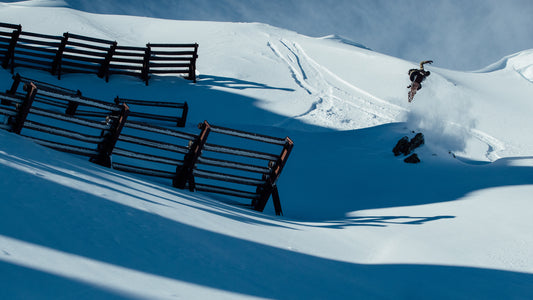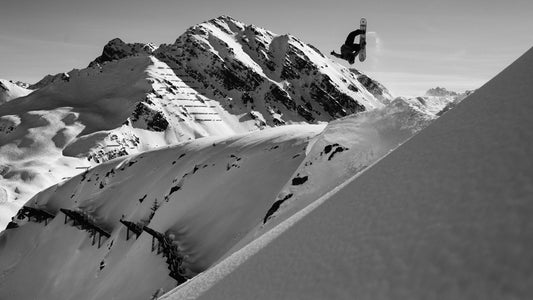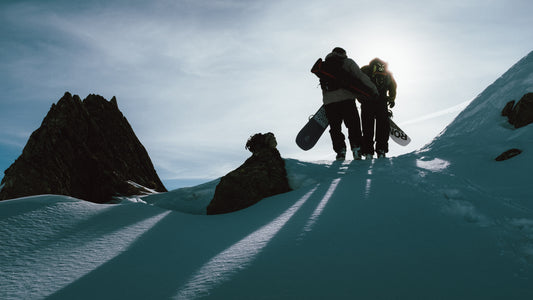Regular, goofy, angles and width explained

If you’re new to snowboarding, figuring out your snowboarding stance can seem a little daunting. With sports like surfing and skating, you can move around while standing and make little adjustments until you feel comfortable, whereas in snowboarding your bindings determine the position of your feet, so you kinda need to dial in your snowboard stance before you even start.
Of course, it’s easy enough to change things up if your snowboard stance doesn’t feel comfortable or you just want to try something different (and we always recommend people experiment; it’s amazing how much of an effect your angles and width can have on your riding) but this guide will tell you everything you need to know to get started.
Snowboard Stance: Regular vs Goofy – What’s the difference?
First thing’s first, as soon as you’ve taken your new bindings out of the box you need to decide which foot is going to be at the front (nose) of your board, and which will be closer to the tail.
The majority of people (around two thirds) find it more comfortable to stand with their left foot forwards. Hence, it’s known as ‘regular’.
Other riders find it more natural to stand with their right foot forwards; this is known as ‘goofy’. Yeah, that sounds a little like an insult but rest assured some of the best snowboarders on the planet – including Rome’s very own Stale Sandbech – have a goofy stance. So why the funny name? No one’s totally sure, but one theory goes that it’s because Goofy the dog once surfed with his right foot forwards for a 1937 Disney cartoon Hawaiian Holiday.
How can I tell if I’m regular or goofy?
Your preferred snowboard stance is not necessarily related to whether you’re right or left handed, or right or left footed (for instance when kicking a ball). It just… is.
Of course, if you already skate or surf then you probably know which feels right, but if you’ve never stood on any kind of board before then there are a few tests you can do to figure this problem out. The classic trick is to ask yourself (or better yet have a go and see) which foot you put forward when sliding on a hard floor in your socks. Unleash your inner kid, tearing up the dancefloor at a wedding!
Another option is to stand with your feet shoulder width apart, and get a friend to push you in the back. Which foot comes forward as you steady yourself? If it’s your left leg, there’s a good chance you’re regular.
A third test is to grab some pants and see which foot you put in first when getting dressed. More often than not it’s the same as your front foot on a board.
As you’ve probably picked up, this isn’t an exact science. If you’re teaching a young kid to snowboard then it can be especially tricky to tell if they’re regular or goofy. Some adults don’t ride a snowboard the same way as they ride a skateboard, or genuinely don’t care which foot is forward (which is lucky if you wanna learn to ride switch). If in doubt, just set your board up with a centered stance and similar angles front and back – we’ll cover that later in this article...
Snowboard Stance Width
The right width for your snowboard stance depends on your individual height, the kind of riding you want to do and simply what feels good.
Every board comes with a reference stance marked on the inserts. Assuming you’ve got an appropriate length board (and our article on how to choose your snowboard size will help with that) then this default is a good starting point. For guys of average height, it’s likely to be around 21 inches (53 cm); for women, it will be more like 19 inches (48 cm).
Screw the bindings down at this position and stand in them to see how it feels. Your feet should be slightly wider than shoulder width apart.
Now play around with the width a little to see what feels best. Ideally you should test each change out for a run or two, because you can never replicate how it’ll actually feel to ride from your bedroom. In fact when it comes to your binding set-up more generally, it’s really worth fiddling about with everything (width, angles and the various other adjustable features) to find out what’s comfortable and better understand how your stance affects the way a snowboard performs.
As a rule of thumb, slightly wider stances (say, 22-23 inches for guys, and 20-21 inches for girls) are better for freestyle riding, because they make you more stable. Some riders even like to max out their snowboard stance by screwing their bindings into the holes closest to the nose and tail.
Narrower snowboard stances are less stable but easier to turn from edge to edge, making them popular with freeriders. As with everything in snowboarding though, trends come and go – today you’ll see less wide stance gangstas than a decade ago; in fact plenty of pros rock a tight stance in the park and pipe, which can help them crank surf-like carves and get their tweak on.
At the end of the day, it’s about personal preference.
Set Back Stance or Centered Stance?
When you’re starting out it’s best to center your stance i.e. position your bindings the same distance from the nose and tail. This gives you balanced performance in either direction – great for learning to ride switch and doing tricks. Plus, if you’re not totally sure if you’re regular or goofy then it gives you the option to ride the other way without changing your snowboard bindings around (assuming the angles are suitable – see below).
If you’re planning to ride deep snow but you don’t have a super directional powder board then it might be worth setting the stance back. This involves bringing the rear binding closer to the tail and moving the front binding down by the same amount (so your nose ends up longer). It allows the tail to sink with less effort, while the extra surface area at the nose will encourage it to float.
If you are gonna try setting back your snowboard stance then just move one hole back on the inserts to start with, to see how it feels. Oh, and never, ever set your stance forward! Whatever kind of riding you plan to do, your nose should always be at least as long as your tail.
What is the best binding angle?
The final piece of the stance puzzle are your binding angles. The disk in the middle of the base plate can be rotated like a cog, with each notch representing three degrees.
Every rider has their own preference when it comes to angles, but there are three basic variations:
1. Positive Front, Flat (or Flat-ish) Back
Rotate your front binding by 15 to 21 degrees (typically) so that the toe is further toward the nose. Set your rear binding to 0 degrees (or perhaps a subtle 3 degrees in either direction).
This is a balanced starting point that prioritizes turns in your normal stance but which will enable you to ride switch without too much trouble.
2. Positive Front, Negative Back aka Duck Stance
Having the toes pointing outward at both the nose and the tail (typically between 15 and 21 degrees on the front and -6 and -15 degrees on the back) makes it easier to ride switch. For this reason it’s usually favored by freestyle riders.
If you’re brand new to snowboarding and you’re not sure if you’re regular or goofy, then a centered duck stance on a twin tip board will let you try using either end as the nose until you figure out what works.
3. Positive Front, Positive Back aka Posi-Posi
Setting positive angles on the front and rear (for instance +18/+9 degrees) shifts your pelvis around so that you’re facing forwards more. This can really help you get low through carves, at the expense of switch-riding ability, so traditionally it’s been the choice of freeriders.
More recently though, a new generation of all mountain freestyle rippers have taken to riding posi-posi to help them achieve a surf-like flow and tricks that are less robotic in style.
Choosing Your Snowboard Stance – The Bottom Line
- Establish if you’re regular (left foot forwards) or goofy (right foot forwards); if you really can’t tell then start out with a centered duck stance.
- For width, begin with the reference stance and experiment with going wider for more stability, and narrower for faster turns.
- If you’re riding powder on a normal board then it can help to move the bindings back an inch or so. A centered stance will work better in the park.
- Binding angles are a matter of preference. Positive/Flat or Positive/Negative (duck stance) is the best place to start.
- Keep experimenting with your stance until you find out what works for your riding style.



